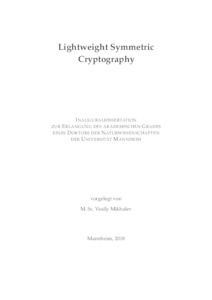|
Lightweight symmetric cryptography
Mikhalev, Vasily
![[img]](https://madoc.bib.uni-mannheim.de/50318/1.hassmallThumbnailVersion/Mikhalev%20_thesis-final-1.pdf)  Vorschau |
|
PDF
Mikhalev _thesis-final-1.pdf
- Veröffentlichte Version
Download (2MB)
|
|
URL:
|
https://madoc.bib.uni-mannheim.de/50318
|
|
URN:
|
urn:nbn:de:bsz:180-madoc-503181
|
|
Dokumenttyp:
|
Dissertation
|
|
Erscheinungsjahr:
|
2018
|
|
Ort der Veröffentlichung:
|
Mannheim
|
|
Hochschule:
|
Universität Mannheim
|
|
Gutachter:
|
Armknecht, Frederik
|
|
Datum der mündl. Prüfung:
|
11 April 2019
|
|
Sprache der Veröffentlichung:
|
Englisch
|
|
Einrichtung:
|
Fakultät für Wirtschaftsinformatik und Wirtschaftsmathematik > Kryptographie (Juniorprofessur) (Armknecht 2010-2015)
|
|
Fachgebiet:
|
004 Informatik
|
|
Normierte Schlagwörter (SWD):
|
Kryptologie , Internet der Dinge , Stromchiffre , Authentifikation
|
|
Freie Schlagwörter (Englisch):
|
Cryptography , Internet of Things Stream Ciphers , Authentification
|
|
Abstract:
|
The Internet of Things is one of the principal trends in information
technology nowadays. The main idea behind this concept is that devices
communicate autonomously with each other over the Internet. Some of
these devices have extremely limited resources, such as power and energy,
available time for computations, amount of silicon to produce the chip,
computational power, etc. Classical cryptographic primitives are often
infeasible for such constrained devices. The goal of lightweight
cryptography is to introduce cryptographic solutions with reduced resource
consumption, but with a sufficient security level.
Although this research area was of great interest to academia during the
last years and a large number of proposals for lightweight cryptographic
primitives have been introduced, almost none of them are used in real-word.
Probably one of the reasons is that, for academia, lightweight usually
meant to design cryptographic primitives such that they require minimal
resources among all existing solutions. This exciting research problem
became an important driver which allowed the academic community to better
understand many cryptographic design concepts and to develop new attacks.
However, this criterion does not seem to be the most important one for
industry, where lightweight may be considered as "rightweight". In other
words, a given cryptographic solution just has to fit the constraints of
the specific use cases rather than to be the smallest. Unfortunately,
academic researchers tended to neglect vital properties of the particular
types of devices, into which they intended to apply their primitives. That
is, often solutions were proposed where the usage of some resources was
reduced to a minimum. However, this was achieved by introducing new costs
which were not appropriately taken into account or in such a way that the
reduction of costs also led to a decrease in the security level. Hence,
there is a clear gap between academia and industry in understanding what
lightweight cryptography is. In this work, we are trying to fill some of
these gaps. We carefully investigate a broad number of existing lightweight
cryptographic primitives proposed by academia including authentication
protocols, stream ciphers, and block ciphers and evaluate their
applicability for real-world scenarios. We then look at how individual
components of design of the primitives influence their cost and summarize
the steps to be taken into account when designing primitives for concrete
cost optimization, more precisely - for low energy consumption. Next, we
propose new implementation techniques for existing designs making them more
efficient or smaller in hardware without the necessity to pay any
additional costs. After that, we introduce a new stream cipher design
philosophy which enables secure stream ciphers with smaller area size than
ever before and, at the same time, considerably higher throughput compared
to any other encryption schemes of similar hardware cost. To demonstrate
the feasibility of our findings we propose two ciphers with the smallest
area size so far, namely Sprout and Plantlet, and the most energy
efficient encryption scheme called Trivium-2. Finally, this thesis solves
a concrete industrial problem. Based on standardized cryptographic
solutions, we design an end-to-end data-protection scheme for low power
networks. This scheme was deployed on the water distribution network in the
City of Antibes, France.
|
 | Dieser Eintrag ist Teil der Universitätsbibliographie. |
 | Das Dokument wird vom Publikationsserver der Universitätsbibliothek Mannheim bereitgestellt. |
 Suche Autoren in Suche Autoren in
Sie haben einen Fehler gefunden? Teilen Sie uns Ihren Korrekturwunsch bitte hier mit: E-Mail
Actions (login required)
 |
Eintrag anzeigen |
|
